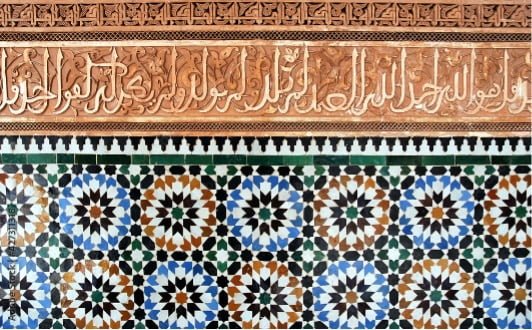In my quest for innovation, I have conceptualized and introduced two new variations of Zelliges, designed to breathe a resolutely contemporary spirit into this ancestral art. This quest for modernity takes shape in two distinct ways. Firstly, by introducing Helio motifs, which boldly depart from established conventions, challenging and reinventing the traditional codes long associated with the repertoire of Zellige shapes. On the other hand, Fen has explored the use of two specific geometric shapes, developed by renowned mathematicians. These so-called Origami forms are characterized by their unique ability to support a random composition, marking a significant break with the centuries-old tradition of repetitive motifs characteristic of Zellige. This innovative approach not only aims to diversify the aesthetics of Zellige, but also seeks to reinterpret it, endowing it with a freer, more experimental dimension that resonates with contemporary aesthetic aspirations.
Helio is characterized by its repetitive motif, whose uniqueness stems from the design of a singular piece. This piece boasts a dynamic silhouette, evoking a slightly altered helix. The elements are arranged to create a rotating movement around a central axis, followed by a linear displacement. This assembly method gives the final surface a resolutely modern look. The rotation has
Origami is inspired by a concept developed by Roger Penrose, an eminent English mathematician and physicist who, in 1970, established a mathematical rule for generating quasi-random arrangements.
These arrangements evoke, to some extent, the structure of quasicrystals. The golden triangle holds key geometric characteristics for the creation of Penrose paving. By first cutting out a golden triangle and enlarging it by a factor φ, then repeating this process ad infinitum, a surface can be completely covered with an infinite number of golden triangles of two distinct types. Applying the golden ratio to the triangle thus enables us to design a totally unique composition. Our aim was to produce a random pattern while minimizing the use of various geometric shapes, and that’s precisely what we’ve achieved with the golden triangle!


1 Comment
Ross
I am really inspired along with your writing skills as neatly as with the
format in your weblog. Is that this a paid
subject matter or did you modify it your self?
Either way keep up the nice quality writing, it’s rare to peer a great weblog like this one nowadays.
LinkedIN Scraping!